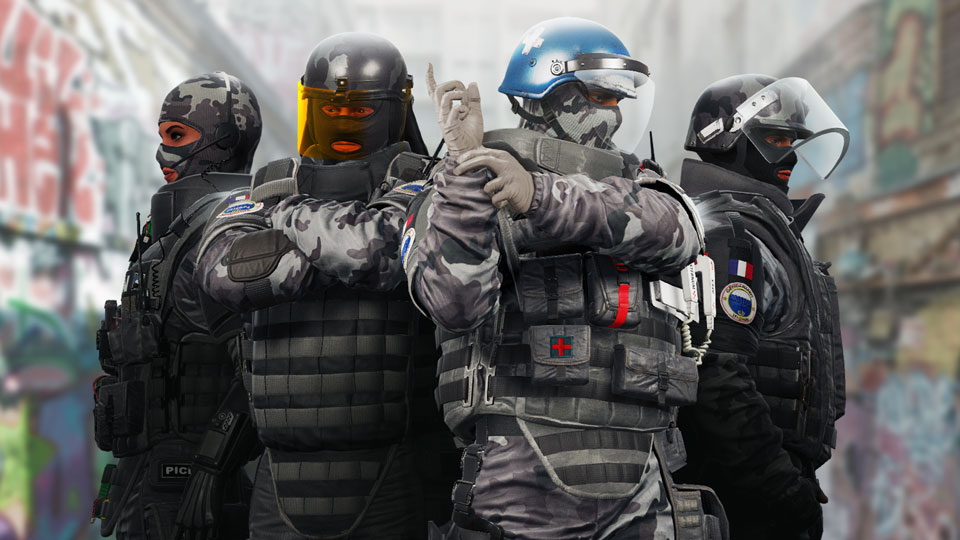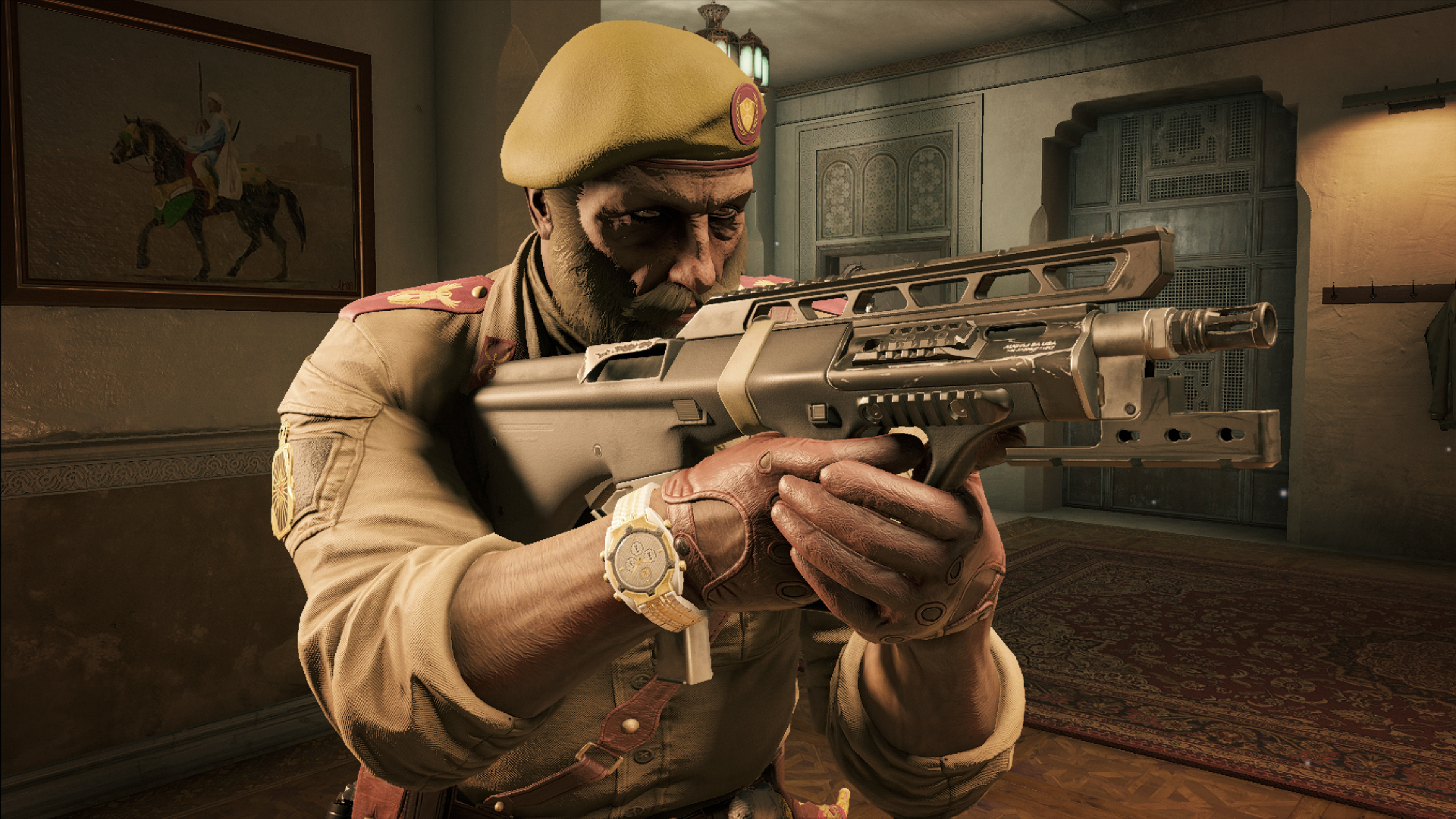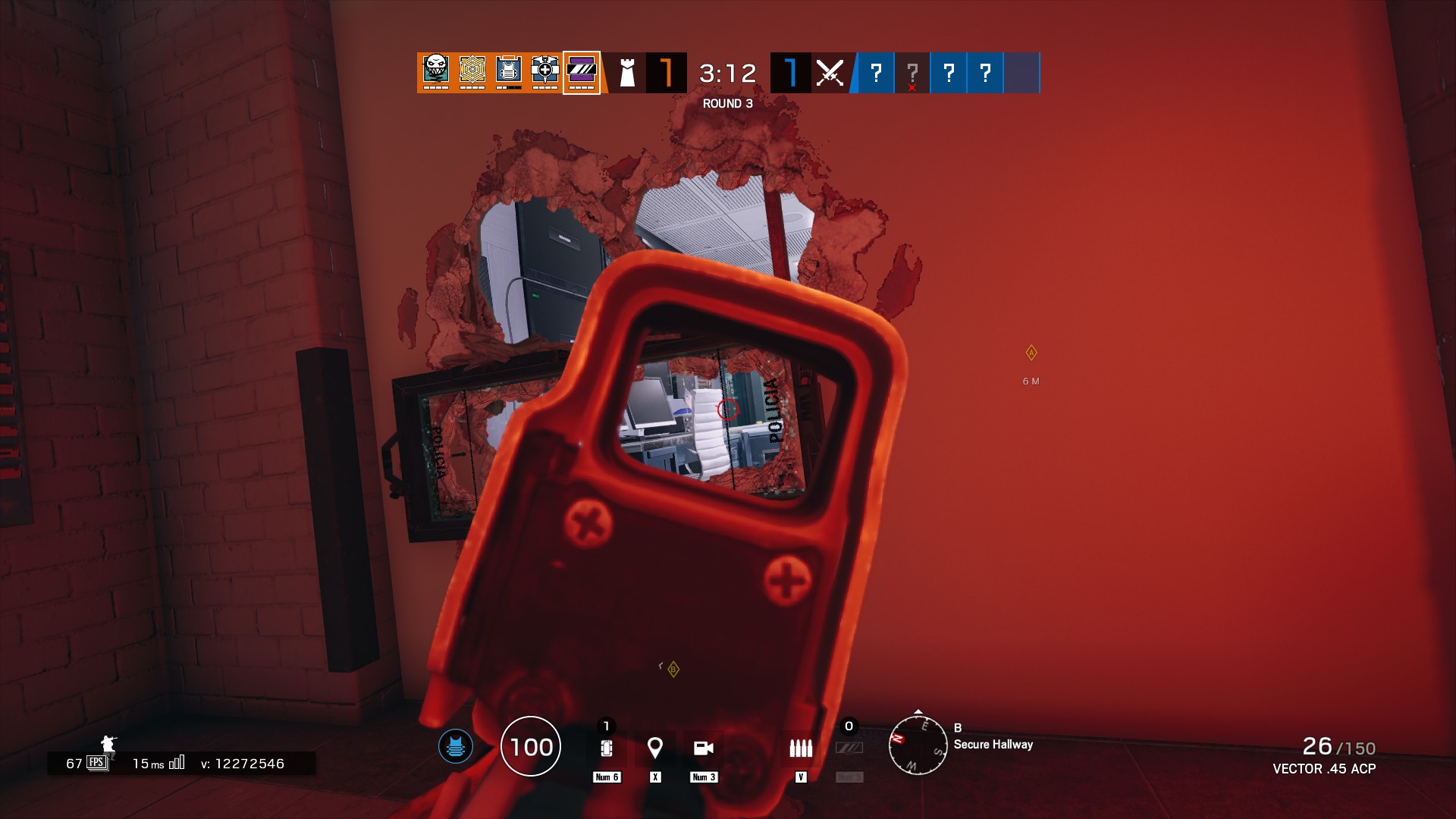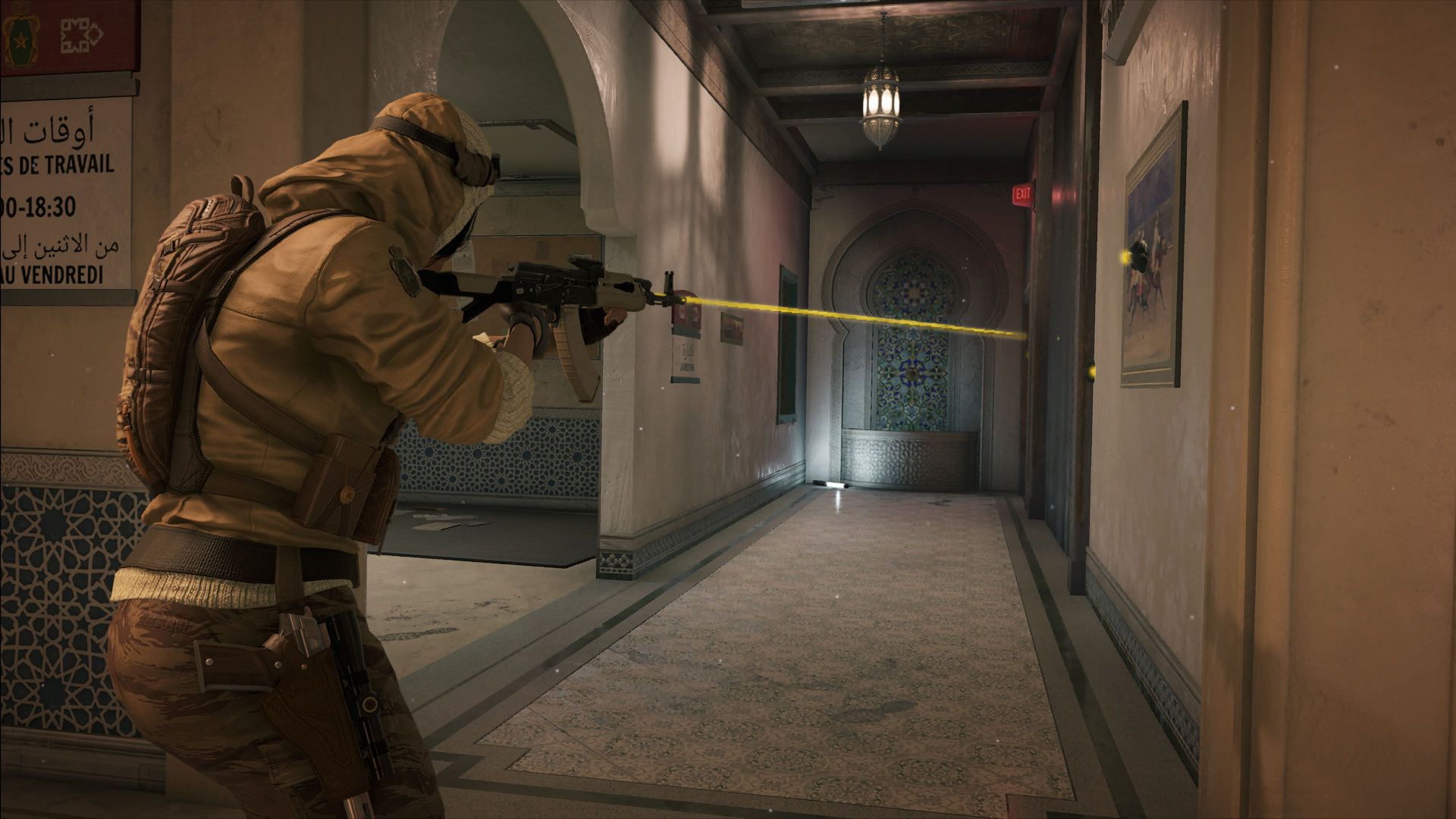
Rainbow Six Siege has dozens of weapons that all take time and practice to master. It’s no small feat, but we’re here to make the learning process a little easier by breaking down all of Siege’s weapon types and attachments to help you find your play style.
Weapons
Assault rifles are held almost exclusively by the attackers and, in terms of raw stats, are the most powerful weapons in Rainbow Six Siege. They punch hard, fire quickly, and sport a superior range to the SMGs held by defenders. The main differences between ARs and SMGs are their damage and effective range. Damage values differ for every weapon, but ARs damage are usually 8-15 points higher than SMGs. They also have superior damage drop off, meaning you can fire from farther away without losing damage in the process.
When using an AR, always take advantage of your superior range ability to use an ACOG scope. Peek from far angles and prioritize opening broader sightlines. You’re also best off taking at least one attachment to help control rapid-fire recoil, like the compensator or vertical grip. If you prefer a more close-range approach, the holographic and reflex sights are valid options.
Submachine guns are held primarily by defenders. Because of their weaker damage, limited sight attachments, and steep damage drop off, they require a more reserved approached compared to assault rifles. SMGs excel at mid-to-close-range combat, which can be perfect for defenders. What they lack in damage and range, they make up for in fire rate and recoil. In most cases, position yourself with an SMG so that the attackers must come to you. Watch closer angles and use your high fire rate to dish out max DPS and overpower your enemy’s assault rifle. Because of their relatively low recoil, SMGs are great candidates for the angled grip that enables quicker aiming.
Light machine guns are held primarily by attackers with the exception of Maestro’s ALDA 5.56. For many players, they’re an interesting alternative to assault rifles with advantages and weaknesses. The most obvious plus for LMGs is the clip size, which is usually at least double that of assault rifles. Time spent reloading is time wasted, but with an LMG, you rarely have that problem. Damage values are about on-par with most ARs, but they do have high recoil and lower fire rates to balance them out. Positioning with an LMG is like using an AR, but longer-range fights are riskier with higher recoil. Mid-range fits the LMG best, but always take advantage of your higher ammo count. Consider skipping the ACOG in favour of a holographic that makes rapid fire manageable. In prolonged firefights, be more aggressive and push in. You’ve got the ammo to spare.
Shotguns are the most situational weapon you’ll find in Siege. Carried by both attackers and defenders, shotguns require an entire shift in play style to best utilize them. One blast can take down an enemy at extreme close range, but any further and you won’t hit much. Each shotgun shell fires eight pellets at a random pattern within your reticule. Each pellet does the advertised damage on the weapon, usually from 30-48. Shotgun positioning is all about catching the enemy off-guard. Lock down close angles, hide in cheeky corners, and avoid long hallways brawls.
There’s always an inherent risk when trying to get so close, but the rewards can be sweet. Shotguns come in a few flavours: semi-auto and pump. Semi-auto shotguns fire quickly at a lower damage while pump shotguns punch harder at a slower speed. Though, there are a couple of outliers. The ACS12 is the only shotgun that can fire completely automatically while the BOSG and TCSG12 (carried by Vigil/Dokkaebi and Kaid respectively) are shotguns that behave more like a DMR.

The marksman rifle, or colloquially the DMR, is an attacker-exclusive weapon type that is fired only at semi-auto. This is the closest that you can get to a proper sniper rifle in Siege. Like shotguns, they’re a different beast than the rest of Siege’s arsenal and require a different playstyle. The biggest advantage for DMRs is their superlative damage drop off. Each shot carries its highest damage over a very long range. This fact, and their controllability makes the DMR the best way to pick off defenders from across the map. Damage swings from 61-71 damage, which easily outperforms ARs. ARs still have the advantage in DPS thanks to their full auto mode, but DMRs are fantastic for those who prefer a more precise tool. If you find yourself struggling to control rapid fire recoil, the DMR is a refreshing alternative.
Pistols in Siege are always a great option as a backup weapon. In most games, sidearms feel like an afterthought, but Siege pistols can drop an enemy at close range just as well as its larger brethren. Damage can range from the 30s to 50s depending on which you use, but it’s important to know that they suffer from steep damage drop off. They won’t do much from all the way down a hallway, but they can end a fight quickly in a pinch when you run out of ammo in your primary. Use them in emergencies, but always try to take fights from close range and fire as quickly as possible to get the most DPS out of your shots. As of last year pistols have almost no recoil, so it can be clutch in a moment of panic.
Attachments
The reflex, holographic, and red dot sights all serve the same purpose of giving a clearer view of where you’re aiming. When it comes to deciding which one to use, it comes down to personal preference. Which reticule gives the clearest picture or makes for easier headshots is up to you, but there are some facts to know. The holographic and red dot sights have the most precise center of aim, but also obscure the most peripheral vision with their outer casing. The reflex sight is a larger triangle with less precision, but has a small casing that doesn’t hinder your view.

The ACOG is easily the most popular attachment around. Usable by every attacker and only a select few defenders, the ACOG is the only sight that magnifies your aim and makes long range shots easier. But it also comes with a few drawbacks. The outer casing blocks much of your peripheral vision while scoped in and it also takes longer to aim. This makes it difficult to use at close range without suffering from tunnel vision.
Most weapons offer the choice of either the angled or vertical grip. The angled grip speeds up the process of aiming down sights (called ADS time) and the vertical grip reduces your recoil and bullet spread. In most cases, players prefer the vertical grip for its help with shooting precisely and winning fights. If you feel like you’ve got a handle on your weapons recoil, consider the angled grip to help you ready your weapon quickly and be ready for surprise skirmishes.
The compensator is the most common muzzle attachment used in Siege. It helps to lower recoil during rapid fire, and since that applies to most weapons in the game, you can’t go wrong with it. Alternatively, the muzzle break drastically lowers the recoil of your first few shots. If you know you’re going to secure a headshot on the first try, it’s a massive help. Try both and see which one matches your shooting habits. If you tend to expunge an entire magazine trying to secure a kill, the compensator is probably your choice.
The flash hider is a bit of an anomaly among the muzzle attachments. Its main function is to eliminate the muzzle flash from your peripheral vision each time you fire. The muzzle flash can slightly obscure the target you’re aiming at, so avoiding this can mean better accuracy. The flash hider also has a slight help to recoil, but only to the first few shots. It’s similar to the muzzle break, but less effective. It’s an interesting tradeoff that means more on some weapons more than others.
Attaching a suppressor significantly reduces the sound of your weapon, but not as much as you’d expect from playing other shooters. Shots can still be heard from very far away, but the real bonus here is with the threat indicator. The threat indicator is the white arrow that appears when someone shoots near you, alerting you from which direction the shots came. Firing with a suppressor won’t trigger this thread indicator, so it can allow you to strike with a lot more stealth. There is a rub, though. The damage reduction will often mean an enemy needs 1 or 2 extra shots to take down. There is also the opportunity cost of reducing your recoil with another attachment, so consider all other options before a suppressor.
The extended barrel is situational as an attachment, but it has its legitimate uses. The extended barrel extends the range that your gun can fire without suffering damage drop off. As we’ve discussed, this is especially useful for SMGs that suffer this drop off the worst. But while it can seem like a no-brainer to use the extended barrel, the extra range will often only amount to 1 or 2 fewer shots needed for a kill. Most players would rather use something that will reduce recoil. The longer barrel can also lead to your giving your position away around a corner because of the longer barrel sticking out.
The laser sight stands alone in its own category of attachment. The laser shoots out of the front of your gun and increases the accuracy of your hip fire. The downside is that the laser is visible to any enemies lurking nearby. In a game where hiding your position is tantamount to victory, giving it away just by aiming down a hallway can be frustrating. For this reason the attachment isn’t seen very often, but if you account for the visible laser it can be a big help.

Wrap Up
We hope this breakdown will help you in your adventures learning Siege, but there’s still a lot to know. It’s important to find the weapons and attachments that work for you, so you can worry about the more important details of Siege. Like not getting shot through a wall.
The biggest gaming news, reviews and hardware deals
Keep up to date with the most important stories and the best deals, as picked by the PC Gamer team.

